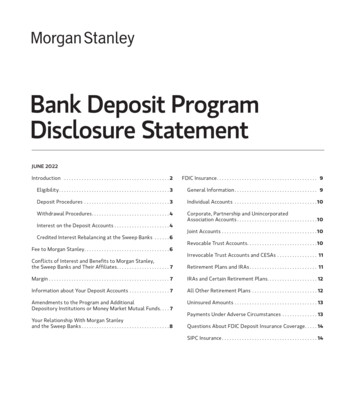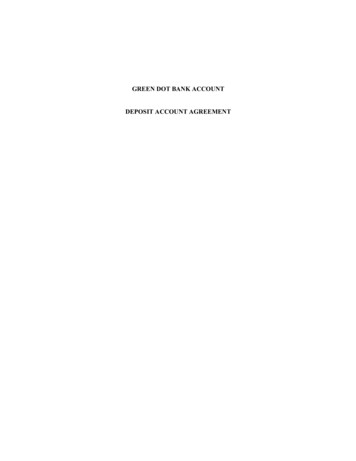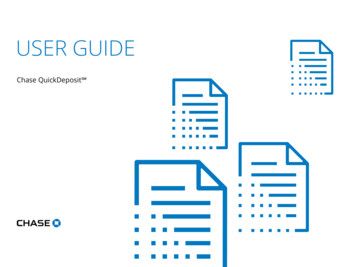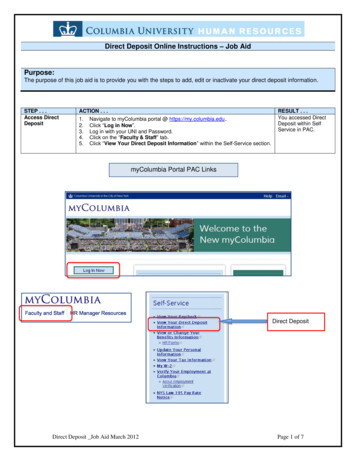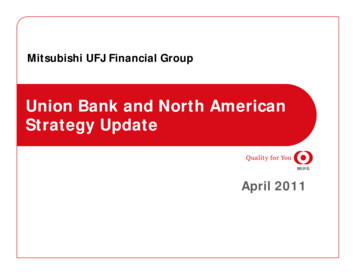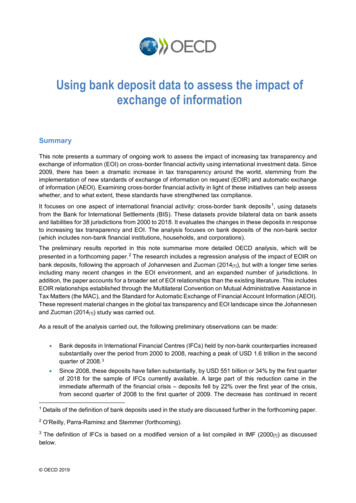
Transcription
Using bank deposit data to assess the impact ofexchange of informationSummaryThis note presents a summary of ongoing work to assess the impact of increasing tax transparency andexchange of information (EOI) on cross-border financial activity using international investment data. Since2009, there has been a dramatic increase in tax transparency around the world, stemming from theimplementation of new standards of exchange of information on request (EOIR) and automatic exchangeof information (AEOI). Examining cross-border financial activity in light of these initiatives can help assesswhether, and to what extent, these standards have strengthened tax compliance.It focuses on one aspect of international financial activity: cross-border bank deposits 1, using datasetsfrom the Bank for International Settlements (BIS). These datasets provide bilateral data on bank assetsand liabilities for 38 jurisdictions from 2000 to 2018. It evaluates the changes in these deposits in responseto increasing tax transparency and EOI. The analysis focuses on bank deposits of the non-bank sector(which includes non-bank financial institutions, households, and corporations).The preliminary results reported in this note summarise more detailed OECD analysis, which will bepresented in a forthcoming paper. 2 The research includes a regression analysis of the impact of EOIR onbank deposits, following the approach of Johannesen and Zucman (2014[1]), but with a longer time seriesincluding many recent changes in the EOI environment, and an expanded number of jurisdictions. Inaddition, the paper accounts for a broader set of EOI relationships than the existing literature. This includesEOIR relationships established through the Multilateral Convention on Mutual Administrative Assistance inTax Matters (the MAC), and the Standard for Automatic Exchange of Financial Account Information (AEOI).These represent material changes in the global tax transparency and EOI landscape since the Johannesenand Zucman (2014[1]) study was carried out.As a result of the analysis carried out, the following preliminary observations can be made: Bank deposits in International Financial Centres (IFCs) held by non-bank counterparties increasedsubstantially over the period from 2000 to 2008, reaching a peak of USD 1.6 trillion in the secondquarter of 2008. 3 Since 2008, these deposits have fallen substantially, by USD 551 billion or 34% by the first quarterof 2018 for the sample of IFCs currently available. A large part of this reduction came in theimmediate aftermath of the financial crisis – deposits fell by 22% over the first year of the crisis,from second quarter of 2008 to the first quarter of 2009. The decrease has continued in recent1Details of the definition of bank deposits used in the study are discussed further in the forthcoming paper.2O’Reilly, Parra-Ramirez and Stemmer (forthcoming).3The definition of IFCs is based on a modified version of a list compiled in IMF (2000[7]) as discussedbelow. OECD 2019
2 years (by a further 12% from the 2008 peak). Disaggregated data between households andcorporates, while available for a smaller number of countries, provide early supporting evidencethat the main impact of EOI has been on individuals, who are now holding fewer deposits offshore. The extent to which this decline can be attributed to decreased tax evasion in response to taxtransparency and EOI, reduced base erosion and profit shifting (BEPS) activity, or other (potentiallynon-tax) factors such as changes in financial regulation, cannot be established with precision. Inaddition, the study focuses only on one kind of financial asset. Nonetheless, the analysis of thechanges in financial flows with the signature of EOI agreements suggests that tax transparencyand EOI play a material role in these changes. Signature of an agreement that enables EOIR between an IFC and a non-IFC is associated with areduction in bank deposits in the IFC with respect to the non-IFC counterparty of between 11% and12%, depending on the specific model used in the regression analysis. This is consistent withearlier findings in the literature, including Johannesen and Zucman (2014[1]). Commencement of AEOI, which is defined as jurisdictions’ intended date of first exchanges witheach other under the Common Reporting Standard (CRS) or a Foreign Account Tax ComplianceAct (FATCA) Intergovernmental Agreement (IGA), is associated with a further reduction in bankdeposits of between 20% and 25%, over and above the reduction associated with EOIR. OECD 2019
31. Introduction1.In 2009, in response to widespread international concern about tax evasion, the G20 declared that‘the era of bank secrecy is over’. 4 Since then there has been a dramatic expansion in tax transparencyworldwide, resulting in ever-increasing commitments from jurisdictions to join exchange of information(EOI) initiatives. To date, over 150 jurisdictions have committed to implement the standard of exchange ofinformation on request (EOIR) and 128 jurisdictions now participate in the Multilateral Convention onMutual Administrative Assistance on Tax Matters (the MAC), providing the international legal basis for alltypes of exchanges. More than 100 jurisdictions have committed to exchanging information related tooffshore accounts automatically and over 90 have already commenced exchanges.2.This increasing global commitment of countries to rising tax transparency and countering taxevasion has resulted in significant interest among stakeholders in gaining an improved understanding ofthe impact of EOI. This note provides a summary of analysis carried out by the OECD and the GlobalForum on Transparency and Information Exchange for Tax Purposes (Global Forum) on the impact of EOI.The preliminary results presented in this note will be included in a more detailed paper, expected to bepublished in the second half of 2019.3.The impact of EOI has been in evidence in a variety of ways. Since the widespread adoption ofEOI, an estimated 500,000 individuals have disclosed offshore assets and around EUR 95 billion inadditional tax revenue has been identified as a result of voluntary compliance mechanisms and offshoreinvestigations. 5 The fact that these sums were in large part disclosed through voluntary disclosureprograms set up in advance of the implementation of automatic exchange of information (AEOI) in 2017points to early evidence of taxpayer behavioural responses to AEOI.4.There is an expanding academic literature that has focused on the impact of EOI on cross-borderfinancial activity. Within this literature, there is an emerging consensus that EOI has resulted in a significantdecline in activity in international financial centres (IFCs). An early paper by Johannesen and Zucman(2014[1]) assessed the impact of EOI by examining the impact of signature of an EOIR agreement on bankdeposits in IFCs, based on the idea that hidden wealth in these centres would be likely to decline inresponse to increased tax transparency. The 2014 paper demonstrated that while EOIR did have an impacton bank deposits, the incomplete nature of the EOI network limited this impact.5.More recent papers, including Menkhoff and Miethe (2017[2]), Casi, Spengel and Stage (2018[3]),and Beer, Coelho and Leduc (forthcoming[4]), have examined the impact of an expanded EOI network, aswell as the impact of AEOI. These papers have all found that EOI is associated with reductions in bankactivity in IFCs. Other papers, notably, Heckemeyer and Hemmerich (2018[5]) and Kemme, Parikh andSteigner (2017[6]), have extended this analysis to portfolio holdings coming from IFCs in OECD securitiesmarkets, and have also found that the expansion of AEOI across the world is associated with reducedfinancial activity in IFCs.6.This policy brief presents the findings of research undertaken by O’Reilly, Parra-Ramirez andStemmer (forthcoming, henceforth referred to as the forthcoming paper), and provides further evidence onthe positive impact of EOI.4G20 Leaders Statement, London, United Kingdom, www.oecd.org/newsroom/44431965.pdfOECD Secretary-General's Report to the G20 Finance Ministers and Central Bank Governors BuenosAires, Argentina July 2018, -g20-finance-ministersjuly-2018.pdf5 OECD 2019
4 2. A timeline of the expansion of global tax transparency7.The expansion of EOI has marked a step change in the tax transparency architecture. Figure 1shows the expansion of EOI of various forms over the course of the last ten years. There is a steadyincrease in the global number of bilateral EOIR relationships from 2009 to 2018 (the blue dashed line).However, more striking than the increase in total EOIR relationships is the extent to which this increase isdriven by MAC signature. The number of global MAC-based EOIR relationships expands substantially after2010. The chart also shows the dramatic expansion in AEOI – first following the commitment of G20countries to exchange information automatically in September 2014, with increasing commitments overthe course of 2014 and 2015.Figure 1. Number of Bilateral EOI Relationships AgreementsNote: Data on bilateral EOIR agreements post-2017 are preliminary and subject to revision. “EOIR agreement signed” refers to the signature ofany agreement that establishes an EOIR relationship, including Tax Information Exchange Agreements (TIEAs), Double Tax Conventions(DTCs), and the MAC itself. To avoid double-counting, agreements that establish an EOIR relationship where one was already in place are notincluded (e.g. instances where two countries sign a DTC that provides for EOIR where a TIEA already provided for EOIR between the twocountries). Data on AEOI exchanges commenced include both AEOI under both the CRS or a FATCA IGA.Source: Data on information exchange agreements provided by the Global Forum.8.Consideration of the impact of the MAC is particularly important, as most of the expansion of EOIhas taken place under its auspices. It does not appear as though any of the major studies in the literatureon the impact of EOI have accounted for the relationships generated by signature of the MAC in theanalysis. Zucman and Johannesen (2014[1]) write that ‘comprehensive multilateral agreement wouldprevent tax evaders from transferring their funds from haven to haven.’ The MAC preforms exactly thisfunction. OECD 2019
53. Methodology and dataData on cross-border bank deposits9.This analysis considers one data source for the purposes of examining the impact of taxtransparency and EOI: data on bank deposits from the BIS Locational Banking Statistics (BIS LBS). Bankdeposits are a key component of cross-border investment activity. These data 6 have been used extensivelyto study the impact of EOI. These restricted data do not only allow for an extension of cross-country andtime-series coverage span but also facilitate separation of bank deposits of non-banks into bank depositsheld by non-bank financial institutions and bank deposits held by non-financial sectors. The latterbreakdown differentiates between bank deposits from households, non-financial corporations and generalgovernment. The new dataset, which complements the already publicly available data, covers 11 countrieswith series available from the fourth quarter of 2013 to the second quarter of 2018. 7810.The BIS LBS offer several advantages over other sources: bank deposit data are among the bestquality data on cross-border financial activity available and information on bank deposits held abroad isspecifically provided for under EOI agreements. Under the assumption that EOI affects cross-borderdeposits, the BIS LBS are a highly relevant data source for informing an assessment of the effectivenessof EOI initiatives.11.This analysis, like others in the literature, focuses on bank deposits towards non-bank actors and,in particular, bank deposits in IFCs held by non-bank residents of non-IFCs. Focusing on non-bankdeposits involves excluding liabilities of banks with respect to other banks, as banks’ lending to each otheron the inter-bank market is unlikely to be impacted substantially by EOI expansion.Data on International Financial Centres12.In order to assess the impact of EOI, it is necessary to use a set of jurisdictions that havehistorically been associated with offshore activity. The definition of what constitutes an IFC is acontroversial subject. In the academic literature, a wide variety of lists have been used, based on a widerange of criteria. These criteria are often subjective. From the perspective of assessment of EOI on bankdeposits, the ideal focus would be those jurisdictions that have specialised in international banking. Thisconstitutes an important caveat, as different IFCs may have different features. For example, some IFCsmay specialise in insurance activity, some as centres for fund activity, and some in banking activity, andso on. Assessing the impact of EOI requires a nuanced understanding of the differences across differentIFCs, and therefore of the varying ways the expansion of EOI is likely to affect IFCs with different profiles.13.The list of IFCs used in this study is based on a list of 46 jurisdictions developed by the IMF(2000[7]). 9 Of the jurisdictions on this IMF list, many smaller centres do not report bank liability data to the6The restricted dataset is available to the Banque de France. It has been used and aggregated by theBanque de France; the results have been submitted to the BIS for approval before being shared.7Following the dissolution of the Netherlands Antilles, Curaçao’s banking statistics are used as anapproximation.8These countries include bilateral data for, on average, 157 counterpart countries.9This IMF report defines an offshore financial centre (OFC) as follows:“[A] centre where the bulk of financial sector activity is offshore on both sides of the balance sheet (i.e.,the counterparties of the majority of financial institutions’ liabilities and assets are non-residents), where OECD 2019
6 BIS. Those who do report some data to the BIS are the Bahamas, Bahrain, Bermuda, the Cayman Islands,Curaçao, Cyprus, Guernsey, Hong Kong, the Isle of Man, Jersey, Luxembourg, Macao, Malaysia, Panama,Singapore, and Switzerland.Data on EOI14.The forthcoming paper examines the two main forms of EOI that have expanded in recent years:EOIR and AEOI. The independent variable for EOIR is the signature of a bilateral or multilateral agreementproviding for EOIR. Such an agreement could be a bilateral agreement such as a Double Tax Convention(DTC), a Tax Information Exchange Agreement (TIEA), or any other relevant multilateral exchange of taxinformation agreement, such as when two jurisdictions both sign the MAC.15.The independent variable for AEOI is either first, a public commitment to exchange informationautomatically or second, the commencement of AEOI under the Common Reporting Standard (CRS), orimplementation of a Foreign Account Tax Compliance Act (FATCA) Intergovernmental Agreement (IGA). 10Taxpayers may have responded to such agreements with varying speeds. Some taxpayers may haveresponded at the earliest possible date, declaring deposits to tax authorities or shifting them out of IFCjurisdictions with the advent of expanded EOI, or they may have waited until the last possible momentbefore EOI would come about. This means that it is useful to separately examine both the announcementof commitment to AEOI as well as the commencement of exchange under AEOI agreements.the transactions are initiated elsewhere, and where the majority of the institutions involved are controlledby non-residents. OFCs are usually referred to as: Jurisdictions that have relatively large numbers of financial institutions engaged primarily inbusiness with non-residents; Financial systems with external assets and liabilities out of proportion to domestic financialintermediation designed to finance domestic economies; and More popularly, centres which provide some or all of the following services: low or zero taxation;moderate or light financial regulation; banking secrecy and anonymity.”The forthcoming paper uses an amended list of IFCs based on the IMF OFC definition. The full amendedlist is as follows: Andorra, Anguilla, Antigua and Barbuda, Aruba, Bahamas, Bahrain, Barbados, Belize,Bermuda, British Virgin Islands, Cayman Islands, Cook Islands, Costa Rica, Curacao, Cyprus, Dominica,Gibraltar, Grenada, Guatemala, Guernsey, Hong Kong, Isle of Man, Jersey, Lebanon, Liechtenstein,Luxembourg, Macao, Malaysia, Malta, Marshall Islands, Mauritius, Monaco, Montserrat, Nauru, Niue,Palau, Panama, Saint Kitts and Nevis, Saint Lucia, Saint Vincent and the Grenadines, Samoa, San Marino,Seychelles, Singapore, Switzerland, Turks and Caicos Islands, United Arab Emirates, Uruguay, andVanuatu. The forthcoming paper also contains a robustness analysis of the main results with respect tothe inclusion of different IFCs.10 Dates for the commencement of exchanges under AEOI are taken from the intended date of firstexchanges as described in the Automatic Exchange of Information Implementation Report 2018 (GlobalForum on Transparency and Exchange of Information for Tax Purposes, 2018[9]), page 3). AEOIagreements are activated on a bilateral basis and exchanges are also bilateral, which is not taken intoaccount in this analysis. Jurisdiction-pairs are coded 1 if both jurisdictions have passed their intended dateof first exchange of information under the CRS or under FATCA, and zero otherwise. However, this doesnot necessarily mean that they are exchanging with each other. The details of which jurisdictions haveactually exchanged with each other are not public at this stage. Incorporating actual activated bilateralagreements could be an avenue for future enhancement of this work. Data on FATCA IGAs are taken olicy/treaties/pages/fatca.aspx. OECD 2019
74. The evolution of cross-border bank deposits amid EOI network expansion16.As previously shown, the expansion of tax transparency, particularly through the expansion ofMAC signature, has led to an unprecedented deepening of the network of exchange relationships. Thisexpansion has been further deepened by the widespread adoption of AEOI.17.Since 2011, there has been a change in the overall trend of deposits in IFCs as compared todeposits in non-IFCs (see Figure 2). In particular, while both deposits in IFCs and deposits in non-IFCsfirst declined in the years after the financial crisis, deposits in non-IFCs have since returned to close to precrisis levels and have recently even surpassed the previous 2008 peak.18.The same cannot be said for deposits in IFCs. Deposits in these jurisdictions rose substantially inthe period after 2000 and rose even faster in the period immediately before the financial crisis, reaching apeak in the second quarter of 2008 (USD 1.6 trillion). Since then, bank deposits in IFCs in respect of nonbanks have fallen substantially, by USD 551 billion or 34% for the sample of IFCs currently available. Alarge part of this reduction came in the immediate aftermath of the financial crisis, where deposits fell by22% over the first year of the crisis, from second quarter 2008 to the first quarter of 2009. The decreasehas continued in recent years (by a further 12% from the 2008 peak).19.The forthcoming paper discusses in further detail the variation across IFCs in these trends.Declines were most evident in Guernsey, the Isle of Man, Jersey, and Switzerland. By contrast, inHong Kong and Macao, for example, there has been an increase in cross-border deposits over time,though in the case of Macao this increase has levelled off in recent years. Disaggregated data betweenhouseholds and corporates, while available for a smaller number of countries, provides early supportingevidence that the main impact of EOI has been on individuals, who are now holding fewer depositsoffshore.Figure 2. Changes in Cross-border Bank Deposits (2000-2017)Note: Data are provided for non-bank counterparties only. Data are aggregated across currencies, type of currency and reporting institutions.Source: Authors’ calculations based on BIS LBS. OECD 2019
8 5. Investigating the impact of EOI on cross-border bank deposits20.To assess the impact of EOI agreements, the analysis relies on a quantitative model in whichforeign-owned bank deposits in IFCs are regressed on various sets of indicator variables switched on uponMAC and EOIR signature, AEOI announcement as well as AEOI commencement (including FATCA IGAs),as an additional mechanism of automatic exchange of information). The key expectation is that, under theassumption that a certain share of offshore tax evasion activity has historically been associated with a lackof transparency in IFCs, where an exchange of information agreement has been entered into, tax evasionactivity through the use of foreign-owned deposits in IFCs becomes much riskier. As a result, it would beexpected that some taxpayers withdraw their assets from EOI-abiding IFCs. The most appropriate pointsin time at which such a response might be expected would be at the time of signature, announcement,ratification or entry into force of EOI agreements.21.The analysis presented in the forthcoming paper follows the same approach adopted in earlierpapers. The set of results in Table 1 incorporates analysis of various types of change to the EOIenvironment, including EOIR signature, AEOI announcement and commencement. The regressionequation is as follows:𝑙𝑙𝑙𝑙𝑙𝑙 ��𝐷𝐷𝐷𝑖𝑖𝑖𝑖𝑖𝑖 𝛼𝛼 𝛽𝛽1 𝐸𝐸𝐸𝐸𝐸𝐸𝑖𝑖𝑖𝑖𝑖𝑖 𝜇𝜇𝑖𝑖𝑖𝑖 𝜃𝜃𝑞𝑞 𝜖𝜖𝑖𝑖𝑖𝑖𝑖𝑖 ,where ��𝐷𝐷𝐷𝑖𝑖𝑖𝑖𝑖𝑖 denotes the bank deposits held in jurisdiction i by residents of jurisdiction j in quarter q.This paper focuses on bank deposits in IFC jurisdictions. 𝐸𝐸𝐸𝐸𝐸𝐸𝑖𝑖𝑖𝑖𝑖𝑖 is a dummy variable that denotes whetheran EOI relationship exists in quarter q between jurisdictions i and j. The results of the analysis arepresented with both jurisdiction-pair fixed effects and time fixed effects. 𝜇𝜇𝑖𝑖𝑖𝑖 stands for a jurisdiction-pairdummy, which is averaging out constant jurisdiction-pair effects such as, for instance, common languageor common legal systems. The variable 𝜃𝜃𝑞𝑞 is a time fixed effect accounting for varying events over timeaffecting all jurisdictions equally such as financial crises, changes in financial market activity or theregulatory environment. 1122.For the sake of brevity, this note reports only the headline results from the baseline specificationin Table 1 below. The forthcoming paper reports more detailed results.11A more detailed description of the models employed is contained in the forthcoming paper. OECD 2019
9Table 1. Regression Results of Bank Deposits in IFCs with Respect to non-IFCs, withJurisdiction-Pair and Quarter Fixed EffectsRegression of bank deposits in IFCs with respect to non-IFCsEOIR OnlyEOIR signatureAEOI Announcement-0.111**0.048AEOI CommencementR2Num. obs.Jurisdiction-pair FEQuarter FE0.00135828YesYesEOIR 5828YesYesEOIR and 828YesYesEOIR and AEOIAnnouncement .0810.00335828YesYesNote: The dependent variable is the stock of deposits held by savers of jurisdiction i in banks of IFC j at the end of quarter q. The unitof observation is the jurisdiction-pair (i, j) and the sample period goes from Q1 2004 to Q1 2018. Statistics reported below thecoefficients represent cluster-robust standard errors, clustered at the jurisdiction-pair level. Data are provided for non-bankcounterparties only. Data are aggregated across currencies, sectors, reporting institutions, and instrument type. ***, **, * refer tostatistical significance at the 1, 5 and 10% level respectively.Source: Authors’ calculations based on BIS LBS, and data on information exchange agreements provided by the Global Forum.23.The results presented from the analysis undertaken provide evidence of a significant negativeimpact of AEOI commencements on foreign-owned bank deposits in IFCs over and beyond the signatureof EOIR agreements. Significantly, AEOI commencement is associated with a decrease in deposits ofbetween 20% and 25%. 12 These results are in the middle of the range of findings in the existing literature,which report that AEOI is associated with a reduction in offshore activity of between 10-40%. 136. Conclusions and caveats24.The note provides new evidence that the expansion of EOI is associated with a reduction in bankdeposits in IFCs. Following the literature, this suggests that the adoption of EOI in many jurisdictionsaround the world is having a positive impact on tax compliance and is reducing offshore hidden wealth.25.However, shifts in deposits are not the only potential response to EOI. Bank deposits may remainoffshore and become tax compliant. Reductions in IFC bank deposits may also respond to othercontemporaneous tax factors including changes in the tax environment of the IFC and the home jurisdictionof the capital owner. These could include changes in statutory rates or changes in tax rules, such as thosethat might result from the implementation of the OECD/G20 BEPS package. Disentangling these variouseffects remains a significant challenge.12The following transformation has been applied to the estimated coefficients for percentage results:100 (exp(𝛽𝛽1 ) 1).13The fact that the independent variables exhibit a substantial time trend (both EOIR and AEOI networksexperience substantial increases over time) and that some of the EOI impact is accounted for by the quarterfixed effects hint at some multicollinearity between the EOI variables and the quarter fixed effects. Theforthcoming paper is aware of the issue and will provide contrasting evidence. OECD 2019
10 26.While these findings provide strong evidence of the positive impacts of EOI initiatives on the scaleand size of offshore deposits held in IFCs, many important areas of future research remain to be explored.For example, future avenues of research to better understand the impact of EOI that could be exploredinclude the direct analysis of increased foreign taxes paid due to EOI (Johannesen et al., 2018[8]) or byextending the existing analysis to consider other kinds of assets held offshore, including shares andsecurities, property and insurance products. OECD 2019
11ReferencesBeer, S., M. Coelho and S. Leduc (forthcoming), “Hidden Treasures: The Impact of AutomaticExchange of Information on Cross-Border Tax Evasion”.[4]Casi, E., C. Spengel and B. Stage (2018), “Cross-Border Tax Evasion After the CommonReporting Standard: Game Over?”, ZEW Discussion Paper, Vol. ard-game-over/?cHash 773b48dcbc608e57114d1b98755f5c3c (accessed on26 October 2018).[3]Global Forum on Transparency and Exchange of Information for Tax Purposes (2018),Automatic Exchange of Information Implementation Report plementation-Report-2018.pdf (accessedon 14 January 2019).[9]Heckemeyer, J. and A. Hemmerich (2018), “Information Exchange and Tax Haven Investmentin OECD Securities Markets”, SSRN Electronic IMF (2000), “Offshore Financial Centers -- IMF Background Paper”, 000/eng/back.htm (accessed on28 January 2019).[7]Johannesen, N. et al. (2018), Taxing Hidden Wealth: The Consequences of U.S. EnforcementInitiatives on Evasive Foreign Accounts, National Bureau of Economic Research,Cambridge, MA, http://dx.doi.org/10.3386/w24366.[8]Johannesen, N. and G. Zucman (2014), “The end of bank secrecy? An evaluation of the G20tax haven crackdown”, American Economic Journal: Economic Policy, Vol. 6/1 B, pp. 6591, http://dx.doi.org/10.1257/pol.6.1.65.[1]Kemme, D., B. Parikh and T. Steigner (2017), “Tax Havens, Tax Evasion and Tax InformationExchange Agreements in the OECD”, European Financial Management, Vol. 23/3,pp. 519-542, http://dx.doi.org/10.1111/eufm.12118.[6]Menkhoff, L. and J. Miethe (2017), “Dirty money coming home: Capital flows into and out oftax havens”.[2] OECD 2019
12 DisclaimersThis document, as well as any data and any map included herein, are without prejudice to the status of orsovereignty over any territory, to the delimitation of international frontiers and boundaries and to the nameof any territory, city or area.This work is published under the responsibility of the Secretary-General of the OECD. The opinionsexpressed and arguments employed herein do not necessarily reflect the official views of the OECDmember countries.Note by TurkeyThe information in the documents with reference to “Cyprus” relates to the southern part of the Island.There is no single authority representing both Turkish and Greek Cypriot people on the Island. Turkeyrecognises the Turkish Republic of Northern Cyprus (TRNC). Until a lasting and equitable solution is foundwithin the context of the United Nations, Turkey shall preserve its position concerning the “Cyprus issue”.Note by all the European Union Member States of the OECD and the European UnionThe Republic of Cyprus is recognised by all members of the United Nations with the exception of Turkey.The information in the documents relates to the area under the effective control of the Government of theRepublic of Cyprus. OECD 2019
Thdatasets proesevide bilateral data on bank assets and liabilities for 38 jurisdictions from 2000 to 2018. It eval uates the changes in these deposits in response to increasing tax transparency and EOI. The analysis focuses on bank deposits of the nonbank- sector (which includes non-bank financial institutions, households, and corporations).
